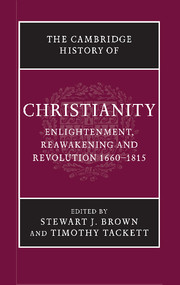Book contents
- Frontmatter
- Introduction
- PART I CHURCH, STATE, AND SOCIETY IN THE EUROPEAN WORLD, 1660–1780
- PART II CHRISTIAN LIFE IN THE EUROPEAN WORLD, 1660–1780
- 5 The Catholic clergy in Europe
- 6 The Protestant clergies in the European world
- 7 Reaching audiences: Sermons and oratory in Europe
- 8 Christian education
- 9 Christianity and gender
- 10 Popular religion
- 11 Jewish–Christian relations
- 12 Architecture and Christianity
- PART III MOVEMENTS AND CHALLENGES
- PART IV CHRISTIAN DEVELOPMENTS IN THE NON-EUROPEAN WORLD
- PART V REVOLUTION AND THE CHRISTIAN WORLD
- Chronology
- Bibliography
- Index
- References
9 - Christianity and gender
from PART II - CHRISTIAN LIFE IN THE EUROPEAN WORLD, 1660–1780
Published online by Cambridge University Press: 28 March 2008
- Frontmatter
- Introduction
- PART I CHURCH, STATE, AND SOCIETY IN THE EUROPEAN WORLD, 1660–1780
- PART II CHRISTIAN LIFE IN THE EUROPEAN WORLD, 1660–1780
- 5 The Catholic clergy in Europe
- 6 The Protestant clergies in the European world
- 7 Reaching audiences: Sermons and oratory in Europe
- 8 Christian education
- 9 Christianity and gender
- 10 Popular religion
- 11 Jewish–Christian relations
- 12 Architecture and Christianity
- PART III MOVEMENTS AND CHALLENGES
- PART IV CHRISTIAN DEVELOPMENTS IN THE NON-EUROPEAN WORLD
- PART V REVOLUTION AND THE CHRISTIAN WORLD
- Chronology
- Bibliography
- Index
- References
Summary
Histories of Christian groups written by their adherents during the seventeenth and eighteenth centuries often highlighted the role of women, viewing their actions as heroic signs of God operating through the least of his creatures. Gottfried Arnold, a German Pietist who published an enormous and sympathetic history of ‘churches and heresies’ in 1729, included a long list of ‘blessed women who showed the way to the truth, or who suffered greatly, or who were amazingly gifted, enlightened or directed by God’. Critiques of these same groups, written by their opponents, also noted women’s power, which they regarded as proof of the group’s demonic or at least misguided nature. Among the ‘errors, heresies, blasphemies and pernicious practices of the sectaries’ described by Thomas Edwards in Gangraena (London, 1646) was the fact that they allowed women to preach. Johann Feustking, a German theologian, turned his attention entirely to women in Gynaeceum Haeretico Fanaticum (Frankfurt and Leipzig, 1704), spending 700 pages describing, as his full title reads, the ‘false prophetesses, quacks, fanatics and other sectarian and frenzied female persons through whom God’s church is disturbed’.
Historians of Christianity in the late nineteenth century often attempted to be more ‘objective’ and ‘scientific’, which meant that they highlighted official institutional and intellectual developments and paid less attention to popular devotional practices or individuals outside the mainstream. Like their colleagues in the newly professionalizing field of secular history, they often left women out of the story altogether as they tried to draw a sharp line between history (including church history) and the ‘softer’ genres of literature and devotional writings.
- Type
- Chapter
- Information
- The Cambridge History of Christianity , pp. 166 - 184Publisher: Cambridge University PressPrint publication year: 2006



